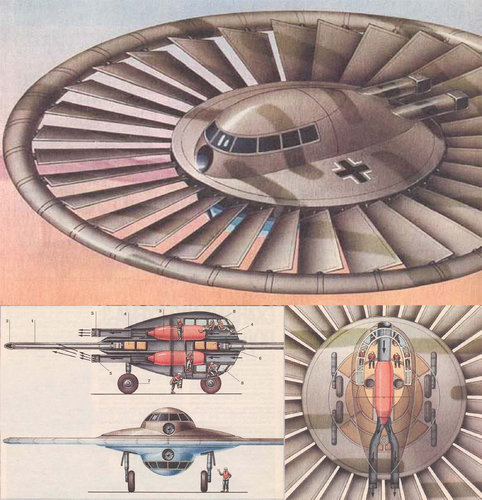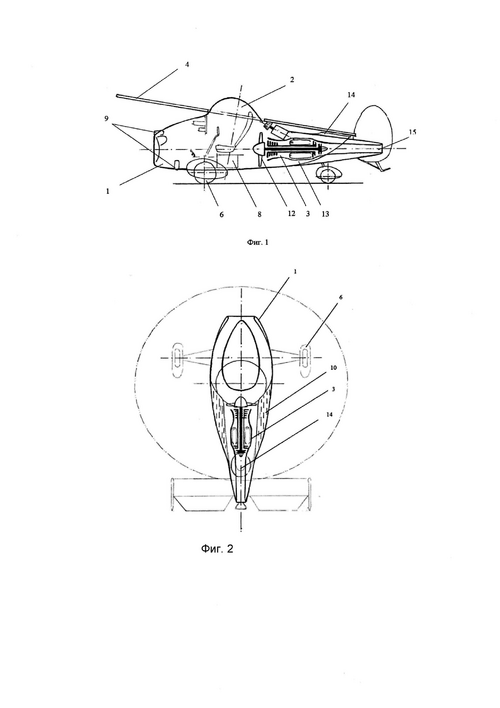German Flying Saucers Bibliography
- ‘
Die Realität der Flugscheiben’ by Andreas Epp, Michaels Vertrieb editor, 2002.
- ‘
Flugscheiben-Realität oder Mythos: Gespräche mit dem Flugscheiben-Erfinder’, by Andreas Epp, Michaels Vertrieb editor, 2005.
- ‘
Die deutschen Waffen und Geheimwaffen des 2. Weltkrieges und ihre Weiterentwicklung’ by Rudolf Lusar, J. F. Lehmann; Edition: 4., stark überarb. u. erw. Aufl. (1962).
- Epp, Joseph Andreas, ‘U.S. Army Intelligence, Record Group 319, Box 186, File Number GE013347’. The National Archives at College Park, College Park, Maryland. -
http://www.archives.gov/iwg/declassified-records/rg-319-army-staff/personal-name-files-new.html
- ‘Evaluation Reports (ER), Final Reports (FR) und Overall Reports der British Intelligence Subcommittee, Reports der Combined Intelligence Objectives Subcommittee (C.I.O.S.) und Field Intelligence Agency (F.I.A.T.)’.
- ‘Hitler’s Flying Saucers: A guide to German Flying Discs of the Second World War’ by Henry Stevens, Adventure Unlimited, 2013.
- ‘Flying Saucer Technology’ by Bill Rose, Midland, 2011.
- ‘Secret Projects- Flying Saucer Aircraft’, by Bill Rose & Tony Buttler, Midland, 2006.
- ‘Jet Planes of the Third Reich-The Secret projects-Volume One’, by Manfred Griehl, Monogram, 1998.
- ‘Secret Weapons of the Third Reich’ by Leslie E. Simon, WE, INC., Publishers, 1971.
- ‘Messerschmitt Me 328
Bordjäger’, by Paul Malmassari, Wingmasters Nº 2.
- ‘
Der Fliegende Bierdeckel’, by Arthur Sack, Die Deutsche Sportflieger, November 1939.
- ‘
Der Kreisflüger AS6 V1’, by Hans Justus Meier, Luftfahrt International 4/79.
- ‘
Aktennotizen und Niederschriftender der ATG-Maschinenbau GmbH.’, Leipzig, von 4.2, 3.2, 17.4 und 18.5, 1944.
- ‘
Veröffentlichungen zuden Modellen von Arthur Sack’,
Der Flieger 11-12/1940.
- ‘
Hochwertige Motorflugmodelle’, Der Deutsche Sportflieger, 9/1940.
- ‘
Das Buch der Deutschen Luftfahrttechnik’, Bidteil, Mainz, 1970.
-
Der Flieger 4/1944.
- Air International, March 1979.
- ‘
Neue formen des Starrflügel-Flugzeuges’, by W. Zuerl,
Der Flieger 1/1944.
- ‘
Dreikomponentenmessungen an einem Kreisflügel mi zwei klappen’, by E. Hildenbrand, Aerodynamische Versuchsanstalt Göttingen, Beritche Nr.40/14/40 vom 3.8.1940 und 41/14/5 vom 21.2.1941.
- ‘
Deutsche Kreisflügelflugzeuge’,
Flugzeug Profile Nr.23.
- ‘
Fliegender Bierdeckel’, by Volker Koos,
Flug Revue 3/1994.
- ‘
Kreisflügler Arthur Sack AS6’, by Volker Koos,
Flug Revue 11/1998.
- ‘Saucers, Swastikas and Psyops’, by Joseph T. Farrell, Adventures Unlimited, 2011.
-
France Soir, June 27, 1952.
- ‘
Erste Flugscheibe flog 1945 in Prag enthullt speers beauftragter’, by Georg Klein,
Welt am Sonntag, April 25, 1953.
- ‘German Discs: UFO in the Third Reich’, Los Angeles Mirror, 24 March, 1950.
- Dortmund Newspaper, Westphalian Overview, 9 July 1947.
- ‘
Deutsche Flugkreisel, Gab’s die?’ Luftfahrt International May/June 1975.
- ‘
Projekt Flugkreisel’, by Rudolph Schriever,
Bremerhavener Zeit entstanden.
- ‘
Untertassen-Flieger Combination’,
Der Spiegel, 30 March, 1950.
- ‘
Flugkreisel Irdisch’, Helm & Welt Nr.14, 2 April, 1950.
- ‘
Fliegende Untertassen’,
Die 7 Tage Nr.26, June 1952.
- ‘
Fliegende Untertasse’, Farb Illustrierte Nr.18, September 1952.
- ‘
Fliegende Untertasse in Deutschland erfunden’, Deutsche Illustrierte, S.1350/51.
- ‘Secret Wings of WWII: Nazi Technology and the Allied Arms Race’, by Lance Cole, Pen & Sword Aviation, 2015.
- ‘
Das gab’s die fliegende untertasse der deutschen Luftwaffe’, ZB Illustrierte für menschen in atomzeitalter Nr.25, December 1953.
- ‘
Wunderwaffen 1945’, Bild am Sonntag, 17 February, 1957.
- ‘
Die UFOs, eine deutsche Erfindung’, Das neue Zeitalter Nr.41, October 1957.
- ‘
Deutsche Kreisflügelflugzeuge’, by Hans Justus Meier,
Flugzeug 2/89.
- ‘
Deutsche Geheimwaffen und Wunderwaffen des II. Weltkrieges’, by Christof Friedrich, Samisdat Publishers, Canada.
- ‘Aeronautical Research in Germany: From Lilienthal until Today’, by Ernst Heinrich Hirschel, Springer 2012.
- Henry Coanda Propelling Device Patents 2,157,281/2,131,472/2,108,653 (10 January 1936).
- ‘Applications of the Coanda Effect’, by Imants Reba, Scientific American, June 1966.
- ‘The Coanda Effect’, by R.S. Sproule and S.T. Robinson. CIOS Reports. File Nº IX (1), 1944.
- ‘The Vanishing Paperclips’ by Hans H. Amtmann, Monogram, 1988.
- ‘
Ich flog als erster eine untertasse’, Kristall Nr.2, 1956.
- ‘Intercept but don’t shoot’, by Renato Vesco, Adventures Unlimited Press, 1994.
- ‘Interceptarlos sin disparar’, by Renato Vesco, Ediciones 29, 1968.
- ‘Intercept UFO’, by Renato Vesco, Pinnacle Books, 1976.
- ‘Man-Made UFOS 1944-1994’, by Renato Vesco & David Hatcher, Adventures Unlimited Press, 1994.
- ‘German Secret Weapons of World War 2’, by Rudolph Lusar, (Review by Reuters in the Washington Post, 18 February, 1957.
- ‘German Secret Weapons of World War 2’, by Rudolph Lusar, Neville Spearman, 1959.
- ‘
Die Deutschen Waffen und Geheimwaffen des 2. Weltkrieges und ihre Weiterentwicklung’, by Rudolph Lusar, J.F. Lehmans Verlag, 1962.
- ‘
Fliegende Untertassen, eine Deutsche Erfingdung’, by Rudolph Lusar
, Das Neue Zeitalter Nr.9, 1958.
-NASM microfilms R 2750 F 268 and R 3216 F 75.
- ‘Messerschmitt Me 328
Bordjäger’, Wingmasters Nº2.
-‘
Flugscheiben über Peenemunde?’ by Leonhard Eckardt & Heiner Gehring, AMUN-Verlag, 2001.
- ‘
Die deutschen Flugscheiben-Konstrukteure, by Andreas Epp,
Sternentorverlag, DVD, May 1999.
- ‘
Die Realität der Flugscheiben’, by Andreas Epp, Michaels Verlag, January 2002.
- ‘
Geheimprojekte der Luftwaffe-Band III’, by Dieter Herwig & Heinz Rode, Motorbuch Verlag Stuttgart 2002.
- ‘
Die Luftwaffe Projekte der Deutschen Luftrüstung -Band 1‘, by Ingolf Meyer, Kissing 2004.
- ‘German Explosive Ordnance TM9-1985-2’, Departments of the Army and the Air Force, March 1953.
- ‘Aircraft Vibration and Flutter Research in Germany’, US Naval Technical Mission in Europe. BIOS Miscelaneous Report 61. 1945.
- ‘
Die Deutsche Luftrüstung 1933-1945 -Band 1 to 4’, by Heinz J. Nowarra, Bernard & Graefe Verlag 1993.
- ‘German Jet Genesis ‘, by David Masters, Jane´s 1982.
- ‘Jet Planes of the Third Reich, the Secret projects Volume One’, by Manfred Griehl, Monogram Aviation Publications 1998.
- ‘Jet Planes of the Third Reich, the Secret projects Volume Two’, by Manfred Griehl, Monogram Aviation Publications 2004.
- ‘German Jet Engine and Gas Turbine Development 1930-1945’, by Antony L.Kay, Airlife 2002.
- ‘Paper Planes of the Third Reich’, Toros Publications 1988.
- ‘German Aircraft New and Projected Type, A.I.2(G) Report Nº 2383’ by H.F. King, January 1946.
- ‘Dragonfly, The Luftwaffe Experimental
Triebflügeljäger project’, by David Myhra, Schiffer 2003.
- ‘Secret Messerschmitt Projects by Willy Radinger & Walter Schick’, Schiffer 1996.
-
Luftfhart International Nº 9, 10 and 17.
- ‘
Flugzeugfahrwerke ‘, by Günter Sengfelder, Motorbuch Verlag Stuttgart 1979.
- ‘
Die Deutschen Raketenflugzeuge 1935-1945’, by Joachim Dressel & Manfred Griehl, Motorbuch Verlag Stuttgart 1989.
-
Die Deutsche Illustrierte, 1953.
-
Welt am Sonntag, 26 April, 1953.
-
Flieger Welt Deutscher Aero-Digest, Heft 1/1951.
-Flugzeug 1/2000.
-Flugzeug 2/94.
-Avionrevue 6/1982.
- ‘German Helicopters’ by Heinz J. Nowarra, Schiffer, 1980.
- ‘Helicopters of the Third Reich’, by Steve Coates, Classics Publications Nº 10, 2003.
- ‘Rotorcraft of the Third Reich’ by Ryszard Witkowski, MMP Books, 2007.
- ‘Doblhoff WNF 342’, by Paul Lambermont, Le fanatique de l’Aviation Nº 120.
- ‘Corona and Induced Current Effects’, Tri-Valley Project PEA, SFO/992220016/November 1999.
- ‘The Coanda Story’, by Martin Caidin, Flying Magazine, May 1956.
- ‘Romanian Inventions And Priorities In Aviation’, by Constantin C. Gheorghiu, Ed., Albatros, 1979.
- ‘The hunt for zero point’, by Nick Cook, Century, 2001.
- ‘
Le dossier des soucoupes volantes’ by Jacques Lob, Dargaud Ed, 1972.
- ‘Gas Turbine Development-BMW, Junkers, Daimler Benz’, by P.Lloyd, CIOS Report. File Nº XXIV (6). C. 1945.
- ‘Gas Turbine Development by BMW’, by P.R. Price. CIOS Report. File Nº XXIV (30). C. 1945.
- ‘German Submarine Rotary Wing Kite’, by B. Kelley and H.J. Mulvey. CIOS Report. File Nº XXVIII (21). C. 1945.
- ‘Ceskoslovenska Letadla 1918-1945’, by Václav Nemecek, Nase Vojsko Praha, 1983.
- ‘Les étranges creations d’Otto Kauba’, by Otakar Saffek, le Fanatique de l’Aviation Nº 272.
- ‘Skoda-Kauba Flugzeugbau’, by Walter Schroeder, Öfh nachrichten, Sonderheft Nr.23, 1998.
- ‘German Gas Turbine Development During the Period 1939-1945’, by J.W. Adderley, British Intelligence Objectives Sub-Committee Report Nº. 12, 1949.
- ‘Centrifugal Compressors’, by L.J. Cheshire, George Newnes Ltd, 1955.
-
http://www.aerospaceweb.org/question/helicopters/q0141.shtml
-
https://en.wikipedia.org/wiki/Hiller_YH-32_Hornet
-
https://www.quora.com/Could-a-helicopter-utilize-a-jet-engine
-https://www.saturdaynightuforia.com/html/articles/articlehtml/taleofthenazisaucer.html
-http://www.ufor.asn.au/wp-content/uploads/2016/04/Real-Flying-Saucers.pdf



